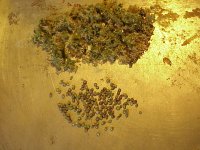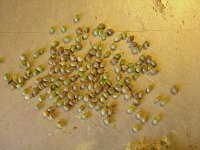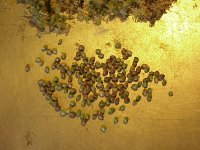CreeperStipule
Active member
I don't recall the specific paper but think the work was on Purple Kush when they looked at that, so -
"The identification of the two QTLs for sex determination across locations is a significant step toward understanding the sex determination system (monecious and diecious) of cannabis. Two auxin response factor genes (arf2 and arf5), bZIP transcription factor 16-like and gene gibberellic acid insensitive (gai) that codes for the DELLA RGL1-like protein were identified in QTLSex_det1 for sex determination. These genes are involved in the balance of the phytohormones auxins and gibberellic acid, which are known to play an active role in the sex expression (male or female) in many crops"
"It is likely that QTLSex_det1 contributes to regulate sex determination by controlling the expression of male and female inflorescences in a female genetic background, for example through downregulation of gai gene and/or downregulation of auxin response factor genes. Both effects might promote the development of male flower organs in female plants, leading to a monecious hemp. This is essentially because the positive effect alleles of QTLSex_det1 are associated to promote monoecy in hemp plants, while the negative effect alleles to promote dioecy (phenotypic values close to 3 indicate monoecy and values close to 1 dioecy, according to the phenotypic scale used in this study). The common genetic basis of monoecy and dioecy sex determination of hemp are in accordance to the common markers between monecious and diecious populations reported by Faux et al. (2016). The argumentation of downregulation of auxin response factor genes is also in agreement with Moliterni et al. (2004). They suggested that the repression of female characteristics implies the down-regulation of the genes involved in pathways more strictly regulated to the differentiation of the female sex."
"Previous studies reported that monecious hemp plants carry the homogametic sex chromosomes XX (Faux et al., 2014) and QTLs associated to sex expression (male vs. female diecious plants and ratio male/female inflorescences in monecious plants) were located on the sex chromosomes, based on genetic maps (Faux et al., 2016). However, the lack of a complete genome sequence do not allow to map the QTLSex_det1 in any specific chromosome. Thus, QTLSex_det1 can be either located on the X chromosome, as some sex QTLs from Faux et al., 2016, or in any of the autosomes. Finally, molecular markers composing this QTL can be used as markers to directly select for monecious plants, differently than the male specific SCAR marker already available. This is because the male specific marker only allows to discriminate between male and female plants (Moliterni et al., 2004)."
A female thing yes?
"The identification of the two QTLs for sex determination across locations is a significant step toward understanding the sex determination system (monecious and diecious) of cannabis. Two auxin response factor genes (arf2 and arf5), bZIP transcription factor 16-like and gene gibberellic acid insensitive (gai) that codes for the DELLA RGL1-like protein were identified in QTLSex_det1 for sex determination. These genes are involved in the balance of the phytohormones auxins and gibberellic acid, which are known to play an active role in the sex expression (male or female) in many crops"
"It is likely that QTLSex_det1 contributes to regulate sex determination by controlling the expression of male and female inflorescences in a female genetic background, for example through downregulation of gai gene and/or downregulation of auxin response factor genes. Both effects might promote the development of male flower organs in female plants, leading to a monecious hemp. This is essentially because the positive effect alleles of QTLSex_det1 are associated to promote monoecy in hemp plants, while the negative effect alleles to promote dioecy (phenotypic values close to 3 indicate monoecy and values close to 1 dioecy, according to the phenotypic scale used in this study). The common genetic basis of monoecy and dioecy sex determination of hemp are in accordance to the common markers between monecious and diecious populations reported by Faux et al. (2016). The argumentation of downregulation of auxin response factor genes is also in agreement with Moliterni et al. (2004). They suggested that the repression of female characteristics implies the down-regulation of the genes involved in pathways more strictly regulated to the differentiation of the female sex."
"Previous studies reported that monecious hemp plants carry the homogametic sex chromosomes XX (Faux et al., 2014) and QTLs associated to sex expression (male vs. female diecious plants and ratio male/female inflorescences in monecious plants) were located on the sex chromosomes, based on genetic maps (Faux et al., 2016). However, the lack of a complete genome sequence do not allow to map the QTLSex_det1 in any specific chromosome. Thus, QTLSex_det1 can be either located on the X chromosome, as some sex QTLs from Faux et al., 2016, or in any of the autosomes. Finally, molecular markers composing this QTL can be used as markers to directly select for monecious plants, differently than the male specific SCAR marker already available. This is because the male specific marker only allows to discriminate between male and female plants (Moliterni et al., 2004)."
A female thing yes?






